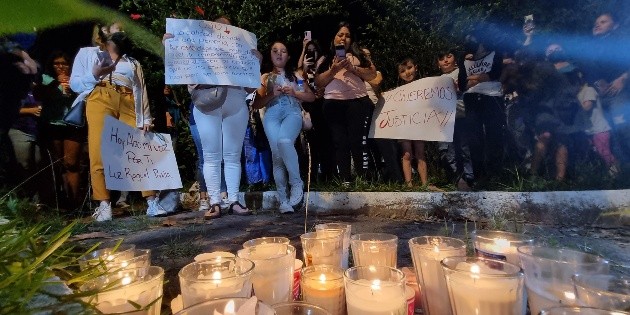According to the new information obtained by the state authorities from various expert reports, the Jalisco Institute of Forensic Sciences (IJCF) has determined that Luz Raquel Padilla is the one who plotted the threatening messages they sent through their social networks last May.
“When analyzing the graffiti and Luz Raquel’s writing, sent by the Public Prosecution Office, sufficient graphic similarities were found to determine that they corresponded to the same graphic origin”confirmed the expert on questionable documents, Quetzalli Meza.
He explained that this was determined by analyzing the letter by Luz Raquel Padilla and Sergio “N”, who are classified as the alleged abuser, and compared it to the paintings painted on the walls outside the woman’s home.
According to expert reports, the letters “a” and “e” of Sergio “N”, for example, differ from the letters of the caliber, so it was concluded that “there are no graphic similarities” that will determine that they were stamped by him “.
“You can see the capital T as it makes a horizontal stroke and makes a downward movement to the right side toward the center, making the main stroke and at the end of the main stroke making a small spike,” the expert explained.
Likewise, the lowercase letter q, which he said has the property of beginning to make the stroke in the upper right part, the body oval, and open on its right side, the clever stroke of medium and the distinguishing feature said to make a hook in the lower part, was analyzed as It is evident from the letter sent by the deputy and in the paintings on the walls.
According to expert reports, the letters “a” and “e” of Sergio “N”, for example, are different from the letters of weights.
He noted that the analyzes were made with the permission of the family of Sergio and Luz Raquel.
The foregoing, with the support of the Director of the IJCF, Gustavo Quezada, was supported by the physical evidence of the matter, which has been implemented at the IJCF for more than 30 years “and has always been based on the criminal principle of conformity of characteristics”.
Jalisco Prosecutor’s Office, pending applications from FGR
The Attorney General of Jalisco, Luis Joaquín Mendez, confirmed that the Attorney General’s Office had intervened in the case of Luz Raquel Padilla, as announced on Tuesday by the Minister of Security and Citizens Protection, Rosa Echel Rodriguez.
Despite this, the attorney general said, the state apparatus will continue to incorporate the investigation file that is being pursued to clarify the events in which Luz Raquel died, whose investigations began after she learned that the woman had been burned alive in a city park. Colonia Arcos de Zapopan, in Zapopan, Jalisco.
“We will wait and respect the decisions that the FGR, as well as the Citizenship Security Secretariat, have to make.what was presented in connection with the technical assistance request that was requested at the end of July this year, Mendez Ruiz stated.
They have analyzed over 250 hours of video
Despite the fact that it was initially said that the neighbors’ cameras that could have captured what happened were not working, the prosecutor confirmed that more than 250 hours of analysis of video clips and digital files have been reviewed so far.
He also said that more than 40 camera points had been verified in and around the scene of the events.
In addition, he asserted, Luz Raquel’s family lawyer has already been given access to all evidence and the entire investigation file, so they will “wait for requests that legal representation may deem appropriate.” I suggest speeding up the procedure.
CG
Read also
Get the latest news in your email
Everything you need to know to start your day
Registration means acceptance of the terms and conditions

“Social media evangelist. Student. Reader. Troublemaker. Typical introvert.”

:quality(85)/cloudfront-us-east-1.images.arcpublishing.com/infobae/TEQF6EONZRFGLLLDIDD4L2O4EE.jpg)

:quality(75)/cloudfront-us-east-1.images.arcpublishing.com/elcomercio/XU32LRAEZFDDPNVHLFU3CKVBYY.jpg)



More Stories
Venezuela ranks fourth in female leadership in science and technology in Latin America
In Portuguesa and Sucre they explore the wonderful world of science
The university court overturns the expulsion of two teachers and a chemical sciences student